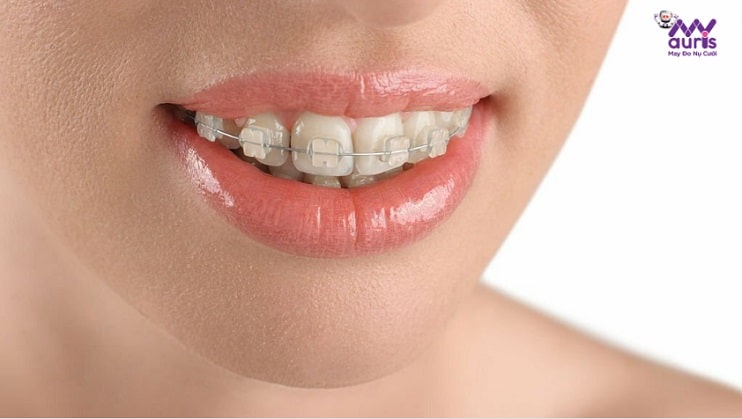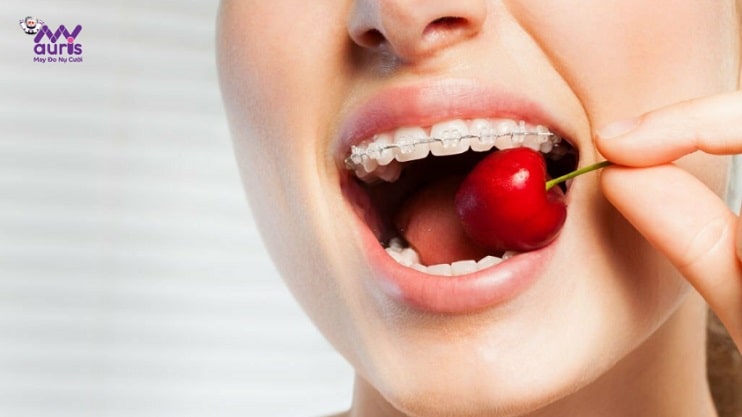Ceramic braces are considered an aesthetic orthodontic technique and a new step in orthodontics. Thanks to orthodontic appliances that help teeth move to the correct bite position with safe and aesthetic porcelain material. Besides, ceramic braces are highly appreciated for their aesthetics, safety and compatibility. So how does ceramic braces work? What are the advantages? And what is the process? Don’t miss the article below!
The mechanism of action of ceramic braces
Ceramic braces is an orthodontic technique using ceramic material High-end, combined with a system of bowstrings and specialized instruments. From there, it creates a stable pulling force and helps widen the jaw, adjust and move the bones to the correct bite. Therefore, the ceramic braces method has the ability to overcome dental disadvantages such as misaligned teeth, malocclusion, etc. Helping you self-print and own a radiant smile, so you can eat and drink with peace of mind and improve your quality of life.
The following cases can use braces. porcelain:
- Cases of crooked teeth, gapped teeth, buck teeth or underbite teeth;
- Teeth with malocclusion;
- A case of jaw bone discordance such as the upper jaw protruding more than the lower jaw; or the lower jaw is more developed than the upper jaw; narrow upper jaw; The lower jaw deviates to the right or left, causing the face to become deformed (distorted); gummy smile.
- Customers with a history of metal allergy when wearing braces;
- In particular, ceramic braces are suitable for people who frequently communicate and need to maintain aesthetics throughout the orthodontic process;

Outstanding features of the method Ceramic braces
Compared to metal braces, ceramic braces possess many outstanding advantages to provide maximum support during the orthodontic process. Typically:
| Evaluation criteria | Braces metal |
Ceramic braces |
| Material | Ceramic braces are made of safe ceramic material, and are resistant to acid abrasion, and prevent irritation of the lips and gums; | |
| Aesthetics | Metal brackets are exposed on the teeth when eating or communicating. Furthermore, this technique is not highly appreciated for its aesthetics because the brackets are exposed during orthodontics; | Ceramic braces are naturally white and match the color of real teeth. In particular, it is difficult to detect when talking face to face at a distance |
| Eating ability chew | Metal frame design is relatively angled, so the eating process can be cumbersome and uncomfortable for users. | Ceramic braces help make chewing activities easy. At the same time, limit adhesion and difficulty in oral hygiene; |
| Adaptability | Metal braces cause irritation to people with sensitive physiques. Furthermore, the first time braces are used due to unfamiliarity and irritation to the soft tissue in the oral cavity; |
Although, the brace method Ceramic braces bring many outstanding advantages, but ceramic braces still have some limitations such as: the cost of braces is higher than metal braces.

The types of ceramic braces are commonly used
There are two main types of ceramic braces: traditional ceramic braces and automatic ceramic braces. Specifically:
Traditional ceramic braces
Regular ceramic braces have the same operating mechanism as metal braces, using elastic to fix the archwire in the bracket sliding groove. From there, a firm force is created, helping the teeth to adjust to the correct position on the jaw. Brings a perfect smile, improves chewing and a balanced face.
However, over time of use, ceramic braces are often susceptible to falling off due to loose elastic ties, or even breakage. Therefore, when wearing traditional ceramic braces, you should periodically replace the elastic bands with new ones as prescribed by your doctor.
Self-ligating ceramic braces
Self-ligating ceramic braces are compactly designed, and use an automatic sliding system to replace elastic bands. Compared to traditional methods, self-ligating ceramic braces limit friction and discomfort for the user.
With the technique of regular ceramic braces and self-ligating ceramic braces, many people wonder which type to choose to achieve the best results. In fact, both methods bring positive results and apply to all cases of tooth defects.
However, the following two types of wires are used for ceramic braces:
- Metal archwire: Has durability and hardness, creating strong orthodontic pulling force. But this wire appears very clearly on the teeth, will help customers communicate, reduce confidence and affect the aesthetic appearance;
- Nickel wire bowstring: This type of wire is the optimal solution for customers with high aesthetic needs. With the advantage of being white, similar to the color of teeth, it will help not reveal it during communication. Furthermore, this improvement makes braces almost invisible.

How is the ceramic braces procedure performed?
Before getting ceramic braces, bracers need to learn the procedure, and choose a reputable dental clinic to achieve maximum effectiveness. Currently, My Auris dentistry is a dental unit that applies medical standards with smart suggestions with AI technology. Furthermore, with standardized ceramic braces procedures and an easy experience with 5 steps:
Step 1: Direct examination and consultation with the doctor
In the first step, the person with braces needs to follow the examination schedule such as taking X-rays with three-dimensional images such as tilted skull, straight skull, panoramic film. This is an important factor in specialized orthodontics, and determines the accuracy of the braces. After that, The patient will be examined directly with the doctor and given detailed advice on the current dental condition as well as a detailed treatment plan.
Step 2: Take dental impressions
After agreeing with the treatment plan, the doctor will clean the patient’s teeth and take samples. jaw impression for storage.
Step 3: Wear braces
The doctor will perform the braces using the correct technique, while ensuring good movement, especially without affecting soft tissue. After completion, the patient will be advised on proper oral hygiene suitable.
Step 4: Regular dental re-examination
Re-examination is a necessary step in the ceramic braces process, because at this time the doctor will check and adjust the arch wire to maintain the braces results.
The entire article above will be useful information on the topic ceramic braces. Based on that, you can consider the braces method that suits your needs and finances. From there, make the most optimal choice. If you want to learn about the service, please contact My Auris dentistry directly, the doctors will advise you in more detail!
Kim Dung





